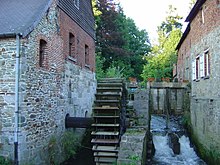Watermill

A watermill is a structure that uses a water wheel or turbine to drive a mechanical process such as flour or lumber production. A watermill that only generates electricity is more usually called a hydroelectric plant.
The technology behind the watermill is somewhat older than that of the windmill. The ancient Greeks and Romans are known to have used the technology; the Romans used both fixed and floating water wheels and introduced water power to other countries of the Roman Empire. The Cistercian Order built huge mill complexes all over Western Europe during the medieval period.
Operation of a watermill


Typically, water is diverted from a river or impoundment to a turbine or water wheel, along a channel or pipe (variously known as a flume, head race, leat, or leet). The force of the water's movement drives the blades of a wheel or turbine, which in turn rotates an axle that drives the mill's other machinery. Water leaving the wheel or turbine is drained through a tail race, but this channel may also be the head race of yet another wheel, turbine or mill. The passage of water is controlled by sluice gates that allow maintenance and some measure of flood control; large mill complexes may have dozens of sluices controlling complicated interconnected races that feed multiple buildings and industrial processes.
"Run of the river" schemes do not divert water at all and usually involve undershot wheels, and some types of water wheel (usually overshot steel wheels) mount a toothed annular ring near the outer edge that drives machinery from a spur gear rather than taking power from the central axle. However, the basic mode of operation remains the same; gravity drives machinery through the motion of flowing water.
Types of watermills
- Grist Mills grind grains into flour
- Saw Mills cut timber into lumber
- Barking Mills stripped bark from trees for use in tanneries
- Spoke Mills turned lumber into spokes for carriage wheels
- Carpet Mills for making rugs were sometimes water-powered
- Textile Mills for weaving cloth were sometimes water-powered
- Powder Mills for making black powder were usually water-powered
- Powder Mills for making smokeless powder were sometimes water-powered
